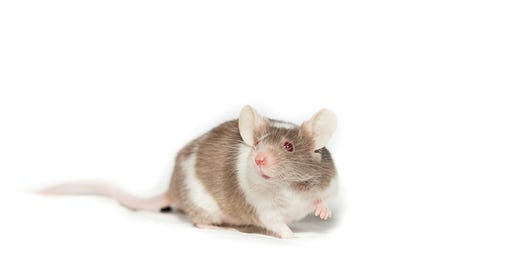My first companion animal was a hamster. While I grew up around dogs—my parents frequently dog-sat and were even doing so when I was born—I never had one to call my own. Like many children, I constantly nagged about getting a dog, and they eventually relented.
That’s not to say my hamster, Joey, was a “consolation pet.” I adored him.
I had gotten the idea that I wanted a hamster seemingly out of the blue, and so my mom took me to the pet store to get one; there wasn’t the kind of resistance there’d been about getting a dog, a fight I still hadn’t won yet. After my friends met him, some of them also ended up acquiring hamsters.
Looking back on that now, it’s scary to think about how much power a six-year-old girl could wield over someone else’s life, how much pain I could—and did, unintentionally—inflict on animals. Even though I try to renounce that power every day, at any moment I could so easily take it back. That scares me a little.
However, I’m not here to talk about that, or about Joey.
This week, I happened to read two books that mentioned rats. One in a positive light, and one negative. But first, I need to bounce back a couple years to yet another book.
In Writing for Animals—a collection of essays published by Ashland Creek Press on, you guessed it, writing about animals—one author, Hunter Liguore, posed a question to the reader: “If you had to choose between [writing about] the snow leopard, the bald eagle, and a mouse, which would you pick?”
Psh, I thought, easy! A mouse!
Liguore continued, “I’m guessing you won’t choose the mouse.”
Um…
I’ve always been fascinated with the common creatures, the ones I see every day. Sure, the exotic animals of the deserts and jungles are intriguing in their own right, but what about the squirrels and rabbits and cardinals I see right in my backyard? Those were the creatures who first stirred my interest in the nonhuman world. My favorite part about visiting my grandma was getting to watch the chipmunk who perched just outside her kitchen window. My days there always started off on a good foot if I got to see him at breakfast.
Back to the present, and I finally tucked into a book I’d wanted to read for years (and miraculously found at the thrift store—only $2!): Unseen City by Nathanael Johnson. This is the kind of book made just for me, all about the wonders of the “invisible” flora and fauna cohabitating alongside humans.
While discussing crows, Johnson remarks that rats, like crows, are among the most playful animals, frolicking just for the sake of it. What a joyful thing! Of all the horrible acts we commit on rats—such as breeding (and killing) them so scientists can make such assertions about their levels of playfulness—it seems especially sad to know how often we assault them just for acting in their nature. How many homeowners are alerted to rats in the attic because the little critters are having a hoot zooming around their new digs?
The second book I read had much more of a rat presence, for the worse. This was The House of Last Resort by Christopher Golden, a horror novel about a couple moving into a home once used for exorcisms. As is often the case in horror, the rats have no personality, no redeeming qualities; they’re there to be gross and scare the humans. (Come on, there’s a demon in this house! Why are the rats the primary scarers?!)
It’s rarely ever recognized that we only consider rats and other “pests” filthy because they live in the filth we produce. Why would rats expend excess energy hunting for food all day when they can simply scavenge our scraps? They’re resourceful, tenacious, unrelenting—traits we often admire in our own species—and yet we condemn them for it.
When it comes to animals, it seems we have little tolerance, much to our own detriment.
Rodents have always been some of my favorite animals. I often find myself distracted by the antics of squirrels outside, the way their tails twitch wildly when they catch me staring, the way they chirp and chitter in the trees, the way they chase each other round and round and leap from branch to branch across chasms of open air.
I wish more people appreciated rodents rather than recoiled at the mere mention of the word. At least I can find solace in the fact that a low bar can always be raised.
On my mind: “Ben” by Michael Jackson
Ben is the 1972 sequel to the rat-infested 1971 movie Willard, following the titular rat as he and his horde cause chaos among human city dwellers. The song “Ben” is initially sung by child protagonist Danny, full of hope and adoration for his newfound rodent friend. Thirteen-year-old Michael Jackson reprises the song—which would go on to become his first solo, chart-topping single—in the film’s closing scene. Watching the end of the otherwise mediocre film, I couldn’t help but tear up as little Danny repeats “I love you, Ben” to his bloodied friend, who had just returned from the full-on assault that killed most of his brethren. I usually have a strong stomach for animal cruelty in fiction, but that was hard to watch.
Up next…
I’m looking for more books that celebrate rodents. Another recent read—Fuzz: When Nature Breaks the Law by Mary Roach—touched on rats and mice. While Roach included some hand-wringing over the ethics of killing these animals, she wrote of few alternatives, instead focusing on the government agencies seeking to eradicate myriad species across the globe.
The next rodential book in the docket is Rats by Robert Sullivan, a look at how and why rats thrive in urban settings. I don’t expect this book to be particularly kind to the little critters but am intrigued nonetheless.
be conscious, be kind, be vegan




